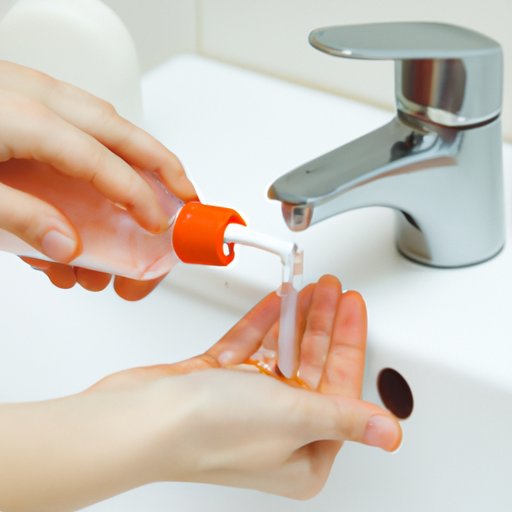
Introduction
Hand, Foot, and Mouth Disease (HFMD) is a common viral illness that can affect people of all ages. It is highly contagious and spreads through contact with infected bodily fluids. While anyone can contract HFMD, young children and infants are particularly vulnerable to the virus, and in some cases, it can cause serious complications. In this article, we’ll explore the causes, symptoms, and transmission methods of HFMD, and provide comprehensive guidelines on how to prevent its spread.
Understanding Hand, Foot, and Mouth Disease
HFMD is a viral infection caused by the Coxsackievirus. It’s prevalent during the summer and fall and is most commonly found in young children and infants. The virus typically causes mild symptoms that can last for up to a week.
What is Hand, Foot, and Mouth Disease?
The signs of HFMD are small, red, or white blisters that appear in the mouth and on the hands and feet. Fever and sore throat may also accompany the rash.
Symptoms
The symptoms of HFMD typically present themselves within three to five days of exposure to the virus. They include the following:
- Fever
- Sore throat
- Irritability and fussiness in young children
- Loss of appetite
- A rash of small, red blisters on the hands, feet, and in the mouth
Causes
HFMD is caused by the Coxsackievirus, which is highly contagious. It spreads through contact with infected saliva, fluid from the blisters, or stool. Children who attend daycare or school are at a higher risk of contracting the virus, as it easily spreads from person-to-person.
Transmission Methods
The virus can be transmitted through:
- Direct contact with an infected person’s bodily fluids
- Touching contaminated surfaces, such as toys, doorknobs, or utensils
- Touching one’s nose, mouth, or eyes with contaminated hands
Preventing the Spread of the Virus
The most effective way to prevent the spread of HFMD is by following these guidelines:
Importance of Regular Handwashing
Washing hands with soap and water for at least 20 seconds is crucial in preventing the spread of HFMD. Everyone should wash their hands frequently, especially after using the restroom, before eating, and after changing diapers. Alcohol-based hand sanitizers can also be used when soap and water are not available.
Mindful Activities and Personal Items
It’s essential to avoid sharing food, utensils, and drinks with others. Parents should also discourage children from sharing toys or personal items, such as towels and blankets. Children should be taught to cover their mouths and noses when coughing or sneezing, to avoid spreading the virus.
Maintaining Good Hygiene
It’s important to keep the environment clean, especially frequently touched surfaces like doorknobs, light switches, and countertops. These areas should be cleaned with a disinfectant regularly. Clothes and bedding should also be laundered frequently.
Seeking Medical Attention
If you or your child show symptoms of HFMD, it’s essential to stay at home and avoid contact with others. Seeking medical attention is recommended, especially if symptoms are severe or a high fever persists for longer than three days.
Avoiding Contact with Others
Combining self-isolation with proper hygiene regulations is crucial in preventing the spread of the virus. People with the flu-like symptoms should stay home from work or school to avoid exposing others to the illness.
Preventing the Spread of the Virus in Shared Living Spaces
In situations where people are living together or in shared spaces, special care should be taken to prevent the spread of the virus. Consider the following guidelines:
Isolating Infected Individuals
People with severe symptoms, or in cases where the infection has spread, should be isolated from others. Infected individuals should also avoid close contact with others until they are no longer contagious.
Disinfecting Surfaces
Shared surfaces should be cleaned frequently with disinfectant, including tabletops, keyboards, doorknobs or railings. Cleaning shared surfaces regularly is essential, especially in shared living spaces.
Properly Disposing of Contaminated Items
Shared clothing, bedding or towels should be handled with care and washed thoroughly. Diapers and other contaminated items should be disposed of carefully and can be tied up in a plastic bag before being discarded.
Avoiding Sharing Personal Items
It’s important to avoid sharing personal items, even in shared living spaces. Each individual should have their own drinking cups, plates, and utensils. Toothbrushes and other personal hygiene items should also be kept separate.
Conclusion
As outlined in this article, Hand, Foot, and Mouth disease is a highly contagious virus, but it is also preventable. Following the prevention guidelines will reduce the risk of getting infected and spreading the virus to others. Maintaining good hygiene, mindful activities and personal items, seeking medical attention when required, and being aware of how the virus spreads are essential precautions.
Emphasize the importance of prevention
While HFMD is a common virus, prevention is the best strategy to avoid the spread of the disease.
Call to action for readers to take preventive measures
It’s important that everyone, especially caregivers and those living in shared spaces, follow the guidelines outlined in this article to reduce the risk of getting sick. Taking preventive measures requires effort, but the benefits are enormous in preventing the spread of this illness.





